Mannarasala Temple of Sree Nagaraja with 10000 idols
The Mannarasala Temple of Sree Nagaraja is an ancient pilgrimage center in Kerala, India, dedicated to serpent gods. It is especially famous for its large number of serpent idols – said to be over 100,000 – adorning the temple paths and nestled among the trees.
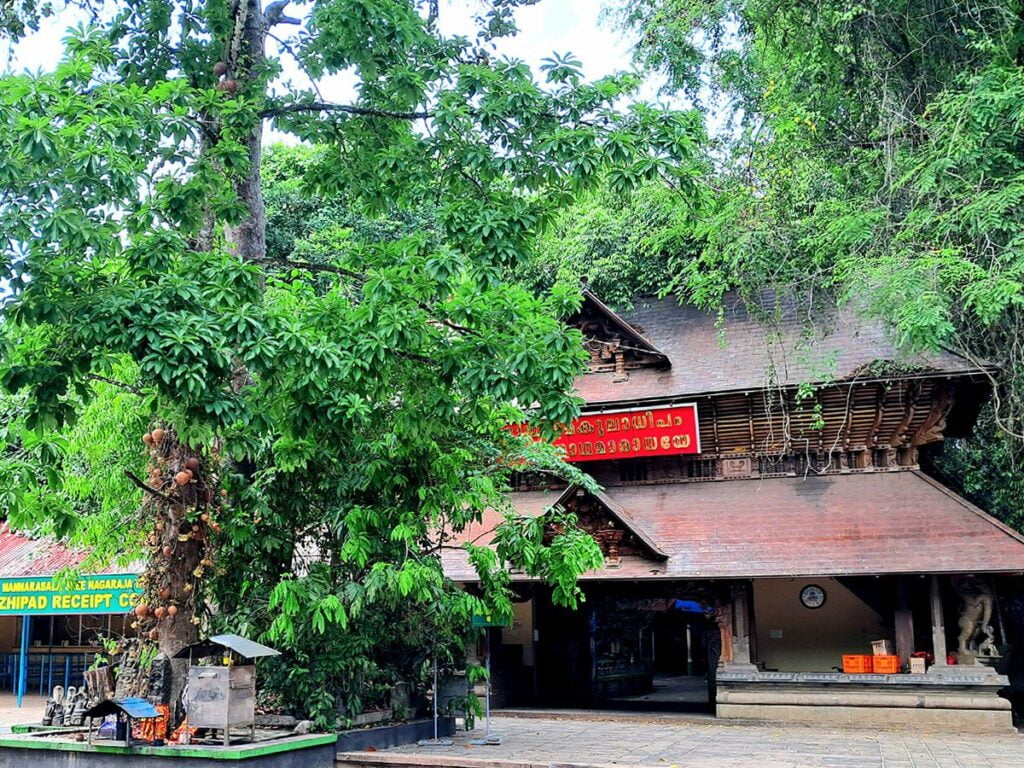
Contents
- 1 Mannarasala Temple History:
- 2 Legend of Mannarasala Temple of Sree Nagaraja:
- 3 Significance of Mannarasala Temple of Sree Nagaraja:
- 4 Myths of Mannarasala Temple of Sree Nagaraja:
- 5 Mannarasala Temple Miracles:
- 6 Mannarasala Temple Timing and Rituals:
- 7 Mannarasala Temple Vazhipadu Details:
- 8 Places to visit near Mannarasala Temple of Sree Nagaraja:
- 9 FAQ:
- 10 How to reach Mannarasala Temple of Sree Nagaraja:
- 11 Google Maps:
Mannarasala Temple History:
- Land Reclamation: Legend says Parasurama reclaimed land from the sea by throwing his axe into it. He gifted this land to Brahmins, but it was infertile due to high salinity.
- Seeking Divine Help: Seeking a solution, Parasurama performed penance to appease Lord Shiva. Shiva, in turn, advised him to worship Nagaraja, the serpent god.
- Nagaraja’s Arrival: Parasurama pleased Nagaraja, who agreed to move to the newly formed land. Nagaraja chose to reside near ‘Mandara’ trees, giving rise to the name ‘Mannarasala’ (meaning ‘grove of Mandara trees’).
- Installation and Rituals: Parasurama installed Nagaraja according to Vedic rites. He appointed Brahmins as priests for performing pujas and included Kshatriyas, peasants, and physicians to help develop the land.
- Unique Tradition: An interesting aspect of the temple’s history is the role of the head priest. According to legend, Nagaraja was once born as the son of the temple’s ‘mother’. Before departing, he decreed that the ‘mother’ herself, and subsequently the senior-most lady in her family, would hold the position of chief priest. This tradition continues to this day.
Read More>> Meenkulathi Bhagavathi Amman Temple
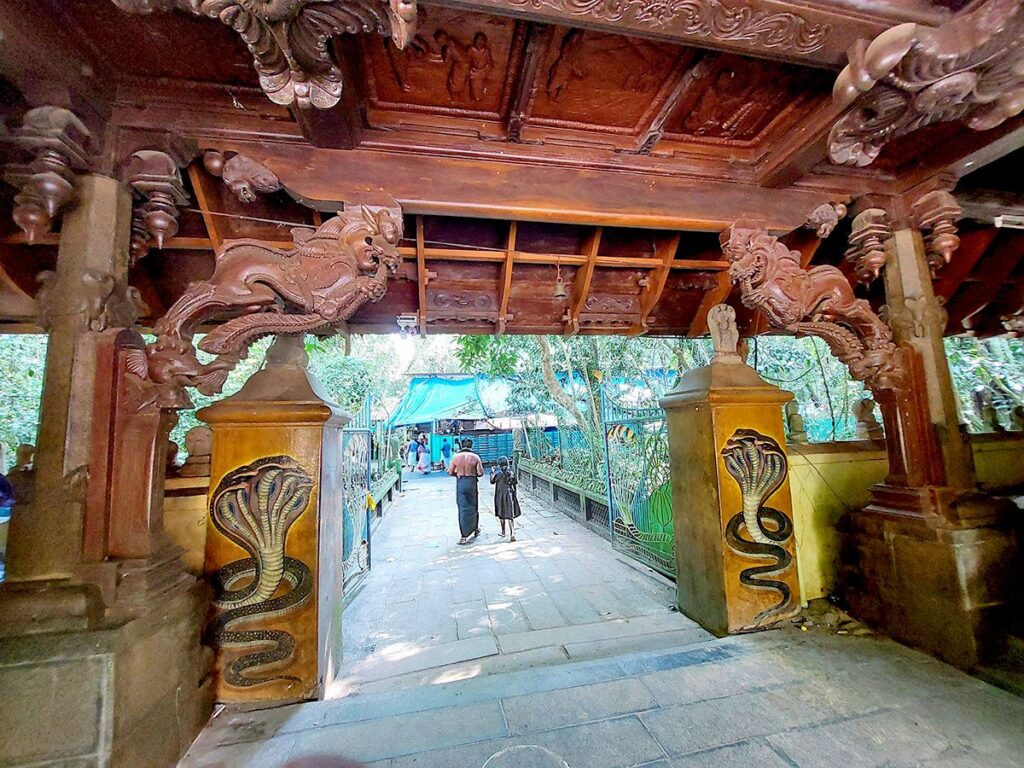
Legend of Mannarasala Temple of Sree Nagaraja:
Legend 1: Parasurama and The Childless Couple
- Lord Parasurama, credited with creating Kerala, gifted the land to Brahmins who found it difficult to inhabit due to high salinity.
- Seeking guidance, Parasurama was advised to appease Nagaraja, the serpent god. He performed rituals with offerings, pleasing Nagaraja.
- Much later, a Brahmin couple, Vasudeva and Sreedevi, residing near the temple were childless. They devoted themselves to worshipping Nagaraja for a child.
- A massive fire erupted in the surrounding forest, causing immense suffering to the serpent community. The kind couple cared for the injured serpents.
- Pleased by their compassion, Nagaraja appeared before them. He offered to be born as their son and permanently reside at Mannarasala in the form of a serpent.
- Sreedevi became pregnant and gave birth to a five-headed serpent child alongside a human child. Both children grew up together, solidifying the bond between the serpent god and the family.
Legend 2: The Priestess and the Five-headed Serpent
- This legend focuses on the temple’s first priestess. Deeply devoted to Nagaraja, she worshipped him relentlessly.
- Miraculously, she gave birth to a child with five serpent heads. Feared and ostracized by the community, she found solace in the temple with her extraordinary child.
- The five-headed serpent grew up to be a benevolent protector, and the temple dedicated to Nagaraja gained immense fame.
Read More>> Ameda Temple of Naga Raja
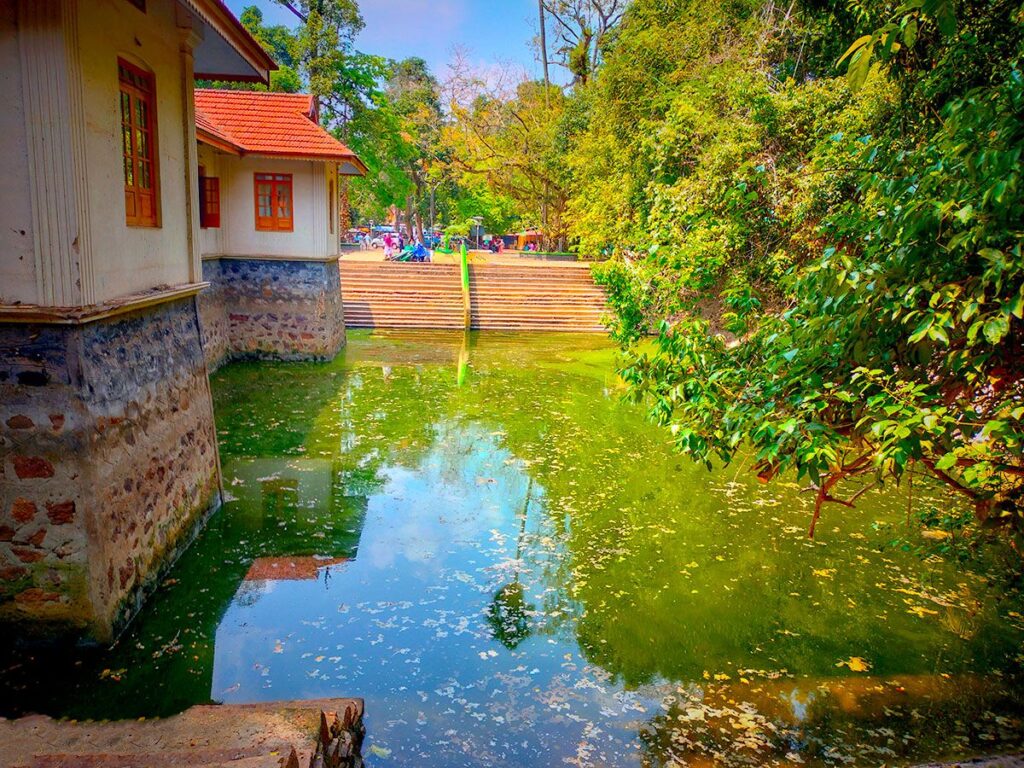
Significance of Mannarasala Temple of Sree Nagaraja:
- Serpent Worship: It’s a prominent center for serpent worship in India. Devotees believe serpent deities hold immense power and can bless them with prosperity, fertility, and protection from harm.
- Unique Practices: The temple has unique rituals and traditions. Unlike most Hindu temples, female members from a specific family lineage perform the poojas (prayers) here, following a custom established by the temple’s legendary origins.
- Fertility and Healing: Couples seeking children come here to pray for fertility. It’s also believed that appeasing the serpent gods can bring healing from illnesses and misfortunes.
- Harmony with Nature: The temple’s association with serpent deities fosters a connection with nature. Snakes are seen as powerful protectors of the environment, and the temple emphasizes the importance of respecting nature’s balance.
- Cultural Heritage: With its ancient history and unique traditions, the temple is a significant part of Kerala’s cultural heritage. The sheer number of serpent idols (over 100,000) itself is a remarkable aspect of the temple’s visual culture.
- Interfaith Acceptance: The temple is said to be welcoming to people from all faiths, reflecting the rich tapestry of religious beliefs in Kerala.
Read More>> Sree Padmanabhaswamy Temple: 8th CE Spiritual Wonder & Mystery
Myths of Mannarasala Temple of Sree Nagaraja:
Here are some aspects of the temple’s lore that touch upon the mythical:
- The Five-Hooded Serpent Child: While some may view the birth of a five-headed serpent child as a miraculous event, defying the natural world, it aligns more with a legendary occurrence.
- Serpent Deities: The concept of serpent gods (Nagaraja, Nagayakshi etc.) themselves hold a mythical quality. They are divine beings associated with serpents, not necessarily literal interpretations of giant snakes.
Interesting Facts about Mannarasala Temple:
- Unique Rituals: The temple is known for its unusual rituals, like the ‘Uruli Kamazhthal’, where offerings are made on inverted clay pots, which some might find strange or outside the norm.
- Snake Idols: The sheer number of serpent idols (over 100,000) adorning the temple creates a visually striking and somewhat mystical atmosphere.
Read More>> Sabarimala Temple: Abode of Lord Ayyappa
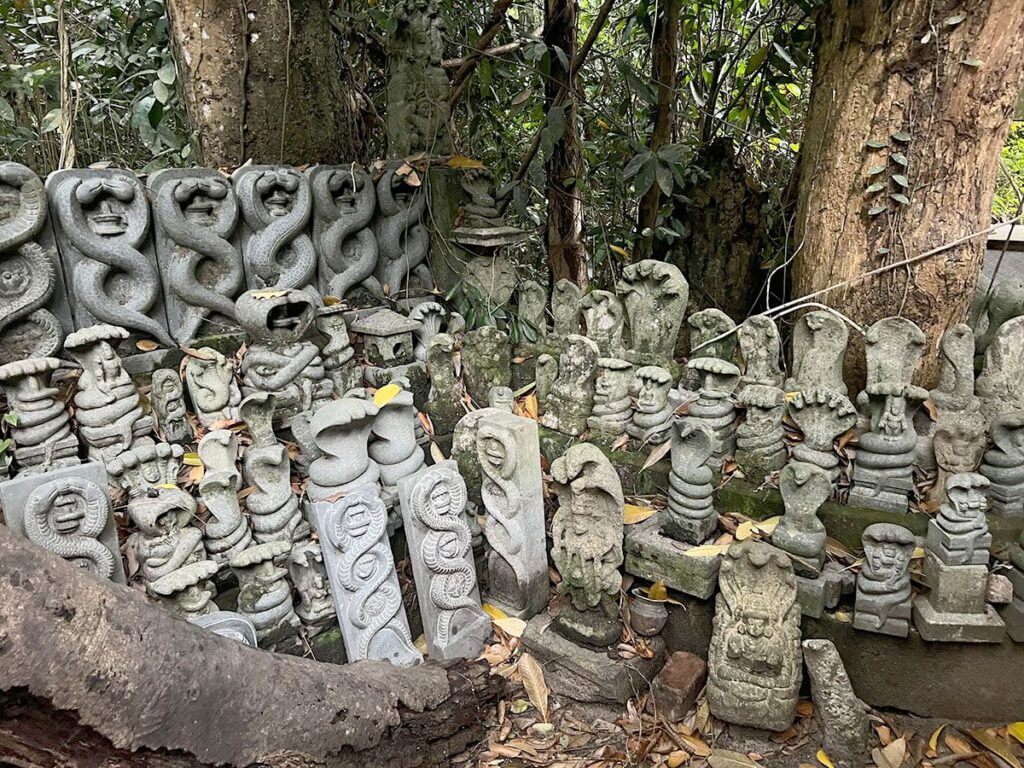
Mannarasala Temple Miracles:
- Blessings for Childless Couples: One of the most common beliefs is that the temple bestows blessings upon childless couples seeking fertility. Legend itself speaks to this miracle, with the story of the childless Brahmin couple, Vasudeva and Sreedevi being granted children through their devotion to Nagaraja. Many couples visit the temple and offer prayers, returning later with thanksgiving ceremonies and offerings after the birth of their child.
- Appeasement of Snake Bites: Devotees believe that the temple has the power to appease the serpent gods and protect them from snake bites. They visit the temple to seek protection and offer prayers in case of snakebite occurrences.
- Wish Fulfillment: General belief holds that sincere prayers offered at the temple reach the serpent deities who grant wishes. Devotees report having experienced positive outcomes in various aspects of life after praying at the temple.
Read More>> Treta Yuga Vaikom Mahadeva Temple
Mannarasala Temple Timing and Rituals:
Timings
The temple timings for darshan (viewing the deity) vary slightly depending on the day of the week:
- Monday to Saturday: 7:00 AM to 11:00 AM.
- Sunday: 7:00 AM to 12:00 PM and 5:30 PM to 7:30 PM.
Rituals
Several daily pujas (prayers) are performed at the temple, including:
- Nirmalyam: Removal of flowers offered the previous day.
- Abhishekam: A sacred bath performed for the deity using various elements like milk, ghee, panchamirtham (a mixture of five ingredients), and holy water.
- Usha Pooja: Puja performed at dawn.
- Ucha Pooja: Puja performed at noon.
- Athazha Pooja: Evening puja.
- Athazha Nivedyam: Offering of food to the deity in the evening.
Special Sevas and Poojas
The temple conducts special sevas (services) and pujas throughout the year. Here are a few examples:
- On the first day of every Malayalam calendar month: Special puja performed.
- Pooyam star day of every Malayalam calendar month: Special puja performed.
- From the beginning of Magha to the eve of Shivaratri: Special pujas performed.
- Thiruvonam in the month of Chingam: Special puja performed.
- From the 1st to the 12th of Karkitakam: Special pujas performed.
- Twelve days before Ayilyam in Kanni and Thulam: Special pujas performed in preparation for the Ayilyam festival.
Ayilyam Festival
The most prominent festival celebrated at Mannarasala Temple is the Ayilyam festival, which falls on the Ayilyam asterism in the Malayalam months of Kanni (September) and Thulam (October). Here’s what happens during the festival:
- All the serpent idols in the temple and the grove are taken out in a procession.
- Offerings of
Nurum Palum(rice flour and milk),kuruthi(a red liquid made of turmeric and lime), and cooked rice are made to the serpent deities.
Read More>> Chottanikkara Temple Ernakulam Kerala
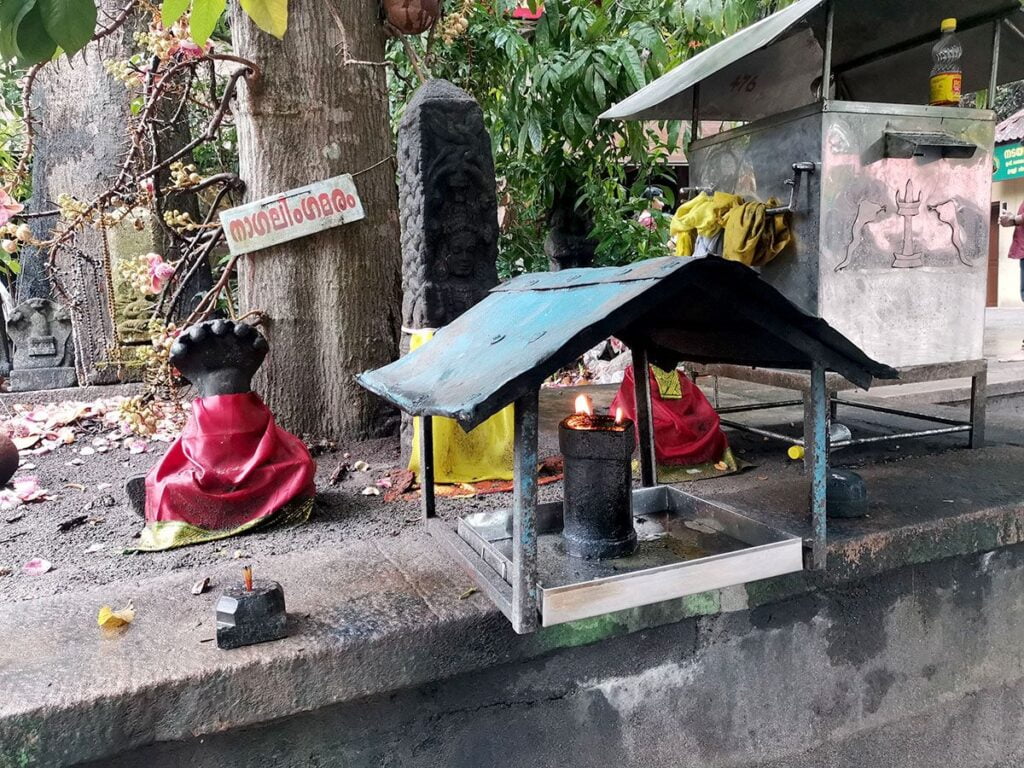
Mannarasala Temple Vazhipadu Details:
Here’s a breakdown of vazhipadu (offerings) at Mannarasala Temple:
Popular Offerings:
- Noorum Palum (Milk and Payasam): This is a common offering to all serpent gods, including Sree Nagaraja and Sree Sarpayakshiamma. It’s believed to appease the serpent deities.
- Nirapara Payasam (Liquid Payasam): This payasam offering is typically made with rice, milk, and jaggery.
- Archana: This puja involves chanting mantras dedicated to the specific deity being worshipped.
- Pancha logam (Five Metal) Offerings: Devotees can offer statues of snakes or other figures made from a combination of five metals like gold, silver, copper, iron, and brass.
- Uruli Kamazhthal: This special puja is meant for appeasing the serpent gods. Details about this puja can be scarce online, so it’s advisable to inquire with the temple directly for specifics.
Online Booking: The temple website offer online booking for pujas (as seen on https://online.mannarasala.org/book). However, double-check the validity of this information through the temple website or by contacting them directly.
Places to visit near Mannarasala Temple of Sree Nagaraja:
- Alappuzha (Alleppey):
- Known for its picturesque backwaters, houseboats, and serene beaches.
- Alappuzha is also famous for the annual Nehru Trophy Boat Race.
- Kumarakom:
- A beautiful backwater destination with lush landscapes and bird sanctuaries.
- Kumarakom is also known for its luxurious resorts and houseboat cruises.
- Ambalappuzha Sri Krishna Temple:
- Famous for its temple architecture and the Ambalappuzha Palpayasam, a sweet milk porridge.
- Aranmula Parthasarathy Temple:
- A historic temple known for its traditional Kerala architecture.
- The annual Aranmula Boat Race takes place nearby.
- Chettikulangara Devi Temple:
- A renowned Hindu temple known for its annual festival, Kumbha Bharani.
- The temple is dedicated to Goddess Bhagavathy.
- Kottayam:
- Explore the cultural and historical significance of Kottayam town.
- Visit Ettumanoor Mahadeva Temple and Thirunakkara Mahadeva Temple.
- Vembanad Lake:
- The longest lake in India, offering boat rides and beautiful views.
- It’s a great place for bird watching and experiencing Kerala’s natural beauty.
- Krishnapuram Palace:
- A historical palace known for its mural depicting the Gajendra Moksha.
- The palace also houses a museum with artifacts from the region.
- Marari Beach:
- A peaceful and less crowded beach known for its golden sands and coconut groves.
- Pallippurathu Kavu Devi Temple:
- A serene temple dedicated to Goddess Bhadrakali.
- The temple is known for its calm and spiritual ambiance.
- Thiruvalla:
- Explore the town of Thiruvalla known for its religious harmony and ancient temples.
- The Parumala Church, a pilgrimage center, is also located nearby.
FAQ:
General Information
- Where is the temple located? Mannarasala Sree Nagaraja Temple is situated in Haripad, Alappuzha district of Kerala, India.
- What is the significance of the temple? Mannarasala is a renowned pilgrimage center dedicated to serpent gods (Nagaraja). Devotees, particularly couples seeking fertility, visit the temple to appease the serpent deities. After childbirth, many return for thanksgiving ceremonies, often bringing new snake idols as offerings.
- Is there a dress code? While there’s no strict dress code, modest clothing that covers shoulders and knees is recommended, as is customary in most Hindu temples.
Legends and Deities
- What is the legend behind the temple? The temple has two popular origin stories:
- Legend 1: Lord Parasurama appeased Nagaraja to make the land habitable. Later, a childless Brahmin couple received a five-headed serpent child as a blessing from Nagaraja.
- Legend 2: The temple’s first priestess gave birth to a five-headed serpent child, who became a protector, and the temple dedicated to Nagaraja gained fame.
- Who are the main deities worshipped? The primary deity is Nagaraja, believed to embody the form of Lord Vishnu and the spirit of Lord Shiva. Other serpent deities include Sarpayakshi, Nagayakshi and Nagachamundi.
Visiting the Temple
- What are the timings of the temple? Generally, the temple is open from sunrise to sunset. However, it’s advisable to check with the temple authorities for any specific timings for pujas or ceremonies.
- What are the special offerings made at the temple? The temple offers various pujas, including ‘Uruli Kamazhthal’, meant to appease the serpent gods. Devotees also offer milk, ghee (clarified butter), and snake idols made of stone or metal.
- How to reach the temple? The temple is well-connected by road. You can take a bus, taxi, or hire a car to reach Haripad.
Additional Information
- Is photography allowed inside the temple? It’s best to inquire with the temple authorities about photography restrictions.
- Are there any festivals celebrated at the temple? The temple celebrates various festivals throughout the year, with the main festival occurring in March/April.
- Is there any accommodation available near the temple? Yes, there are guesthouses and hotels in Haripad to suit various budgets.
How to reach Mannarasala Temple of Sree Nagaraja:
By Air: The nearest airport to Mannarasala Temple is the Trivandrum International Airport (Thiruvananthapuram), which is approximately 121 kilometers away. From the airport, you can hire a taxi or use other public transportation to reach the temple.
By Train: The nearest railway station is Haripad Railway Station, which is around 3 kilometers away from Mannarasala Temple. You can take a train to Haripad from major cities in Kerala and other parts of India. From the railway station, you can hire a taxi or use local transportation to reach the temple.
By Road:
- From Trivandrum: Mannarasala Temple is approximately 121 kilometers away from Trivandrum. You can take a bus or hire a taxi from Trivandrum to reach Mannarasala.
- From Kochi: The distance from Kochi to Mannarasala Temple is approximately 117 kilometers. You can either drive or take a bus from Kochi to reach the temple.
- Local Transportation: Once you reach Haripad or the nearby areas, you can hire a taxi or use local buses to reach Mannarasala Temple.
